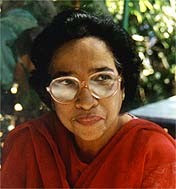A sudden interest in the life of the American Drama
teacher Emily Hale has cropped up,
with the opening of her
cache of 1131 love letters, fifty years after her death. These letters had been
deposited in the Princeton University Library in 1956, and was opened in
January 2020, in accordance with her wishes. The letters will be of interest
because they will reveal the secret love life of a woman, who was not just the
muse of the poet T.S. Eliot, but also his lover and confidante.
Emily Hale was born on October 27th 1891, in
New Jersey, to Reverend Edward Hale a Unitarian minister and his wife. But she
was brought up by her aunt Edith Perkins and her uncle Reverend John Carrol
Perkins in Boston. She attended Berkley Street School in Cambridge and Miss
Porter’s School in Farmington, Connecticut, but did not go to college. She
became a Speech and Drama teacher and worked in many universities in the US.
Emily always wanted to be an actor but was prevented from doing so by her
conservative aunt and uncle. She became a member of the Amateur Cambridge
Theatre and took part in many plays that were well received.
Emily first met T.S. Eliot the poet in 1912, at his
cousin’s house. He was then doing a course in Philosophy at Harvard. In 1913,
the Amateur Theatre group produced a scene from Jane Austen’s ‘Emma’ in which
Emily and Eliot performed. Eliot seemed to have fallen in love with this slim,
graceful girl with a smiling face, and he professed his love for her before he
returned to England in 1914. However, in spite of his confession of love for
Emily, he went back and got married to a girl called Vivienne Haigh-Wood.
In 1932-1933, Eliot visited Emily and decided to seek
separation from his wife on grounds of sexual incompatibility. He could not
divorce her because he was of the Anglican faith. Vivienne became mentally ill
and had to be admitted to a mental hospital, where she died in 1947.
Emily spent her summers with her uncle and aunt at
Campden, Gloucestershire between the years 1935-1939. During these visits, her
friendship with Eliot was revived and they spent many hours together. In 1935,
he even wrote a poem ‘Burnt Norton’ named after a home in England which they
had visited. He said it was his love poem to her. This was the first of many
poems he wrote, declaring that Emily was his muse. It was the beginning of
their epistolary romance which saw many letters exchanged between them. But the
contents of her letters to Eliot were never known as he burnt them all. Emily preserved
each one carefully, secretly exulting in the love he professed. Their
correspondence lasted from 1930-1956.
If Emily hoped that Eliot would marry her after
Vivienne’s death, she was sorely disappointed. Many of his friends thought she
was too prim and boring. She had to settle for platonic love in their
relationship. Eliot’s last letter to her was in 1956.
But when Eliot married his secretary Valerie Fletcher,
thirty years his junior in 1957, Emily could bear it no more. She came to know
of it through a mention in the Boston Globe. She had a nervous breakdown and
had to undergo therapy. Some wise man had cautioned “Never date a poet. He’ll
always do a dirty on you,” and that is what happened. Was it Emily’s lack of
self love and self esteem that permitted Eliot to ride roughshod over her
emotions? In the end Eliot had the gall to say “Emily would have killed the
poet in me.” He died in 1965.
In time, Emily snapped out of her ‘Broken Heart syndrome’
with surprising resilience. She began to work again and continued to teach at the
Abbot Academy of Drama from 1947- 1959.
Emily led a quiet life after her retirement until her death
on October 12th 1969. Unworthy as he was, she kept a photo of Eliot on
the bureau in her apartment. Though her life was nothing but emotional chaos, she
never bared her heart to the world. Now that those letters from Eliot are open to
scrutiny, the literary world will have more details of that ambiguous relationship.
As Anthony Curd an Eliot scholar said, “This is perhaps the literary event of the
decade. I don’t know anything more awaited or significant. It is momentous to have
these letters come out.”
